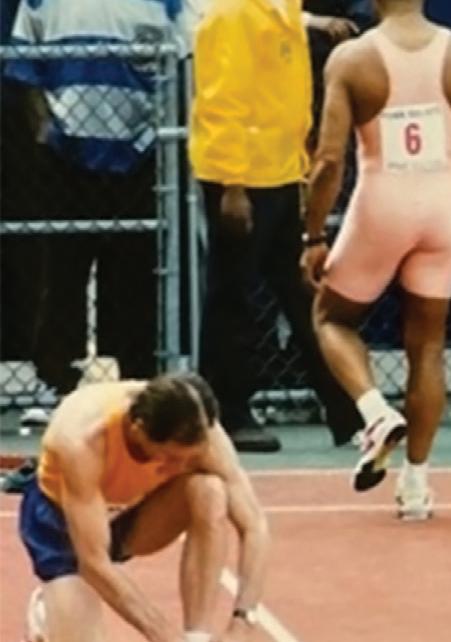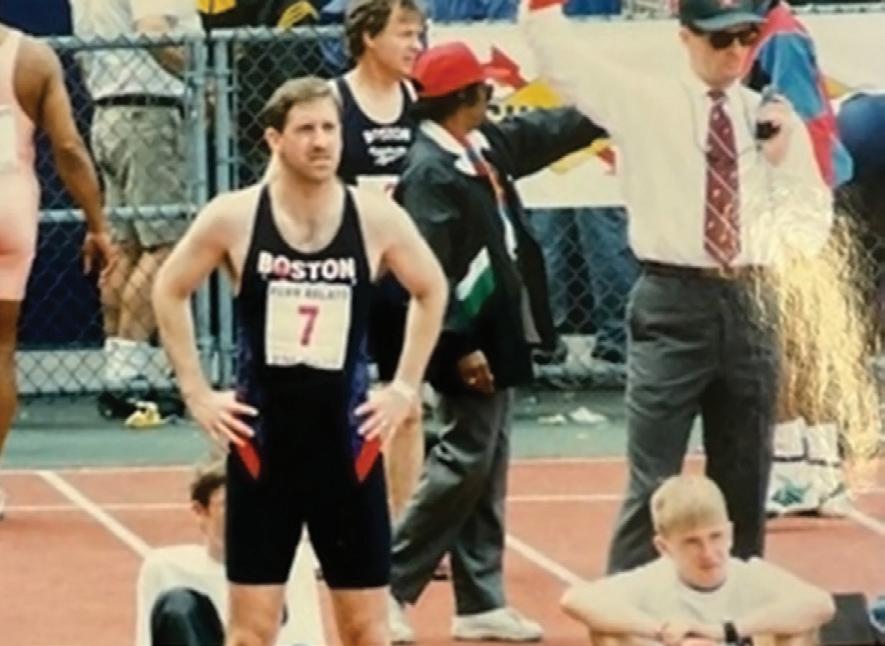
5 minute read
Lessons Learned in Sports Aided Neil Steinberg’s Career in Banking and Philanthropy
The sprinter turned business leader relied on lessons he took from track eil Steinberg rarely ran the fastest leg on his relay teams in high school and college. “When I handed off the baton, I wanted [my teammates] to be faster,” he said. Steinberg was fast — he still shares the 100-yard dash record of 9.7 seconds at West Haven High School in Connecticut — but if his teammates were faster, he reasoned, the team stood a better chance of winning.
That commitment to team performance over individual glory sustained Steinberg on the track at West Haven High and Brown University and helped him excel as a banker, fundraiser, and advocate for the public good in a career that will end this month just shy of 50 years.
Steinberg, 69, was president and CEO of the Rhode Island Foundation, one of the oldest and largest of the 800 community foundations in America. It was founded in 1916. The Rhode Island Foundation raises money from philanthropic individuals and companies, invests those dollars and distributes the returns to Rhode Island nonprofit organizations. In 2022 the Foundation raised $75 million and awarded $84 million to 2,400 Rhode Island nonprofits.
Steinberg has been in charge since 2008. Before that he was Chief Development Officer at Brown, where he led all fundraising, including a $1.4 billion capital campaign. And before that he was a corporate loan officer and eventually CEO and President of Fleet Bank of Rhode Island.
The amazing thing about his career is that he planned none of it. But as we talked about those decades at Fleet, Brown and the RIF, he described how lessons he learned from sports helped him succeed in business.
SUCCESS CAN FOLLOW FAILURE.
Steinberg recalled his first baseball adventure.
“When I was nine years old, I did not make the Little League team on my first try,” he told me. “So I spent that summer throwing tennis balls against the garage and swinging a heavy bat. When I was 10, I made the team. I was a fast singles hitter.” The lesson? “If you fail, get up and dust yourself off.”
OPPORTUNITY KNOCKS WHEN YOU DON’T EXPECT IT.
Steinberg played soccer in the fall of his freshman year at West Haven High. That spring he tried out for the baseball team. Shagging flies in center field, he decided to show off. Instead of hitting the cutoff man, he threw to home plate, injured his arm, and did not make the team.
As a sophomore Steinberg played soccer. His coach talked him into running track instead of trying out for baseball again. He ran the 100, 200, low hurdles and relays almost every meet.
“Once in a while I had to run a 400. I’ve never done anything in my business career as difficult as running a 400,” he said. Once around the track at a full sprint is a serious test. Brown and the University of Connecticut recruited him to play soccer, but he went straight to track. “I didn’t set out to be a track guy. If I had made the baseball team, none of this track stuff would have happened,” he said.
BECOME A STUDENT OF THE GAME.
Steinberg’s first track memory was the 1968 Olympics in Mexico City, the games of American Bob Beamon’s world record long jump and the raised fist protest of American sprinters Tommie Smith and John Carlos. Inspired, Steinberg bought a book on how to become a sprinter. He was so excited that he persuaded his high school coach to allow him to work several tips into practice.
PAY ATTENTION TO DETAILS.
Steinberg’s specialty, as he put it, was not speed but “being the organizing guy” for his relay team. He made sure they checked in on time, they had their baton, and their names were on the signin card. He placed strips of adhesive tape on the track to mark their starting positions.
“It worked,” he said.
LEARN TEAMWORK AND LEADERSHIP.
A team captain at Brown for two years, Steinberg did not aspire to be the speedster in every race. Instead, he enjoyed “coordinating and leading a whole bunch of people who were faster sprinters than I was. . . . motivating, collaborating, bringing the team together.” He remembers the year at the Penn Relays in Philadelphia when his relay team raced against Olympic gold medalist Carl Lewis and a team from the Santa Monica Track Club. Steinberg and friends finished ahead of Lewis and his crew. “How did we do it?” Steinberg asked. “They dropped the baton.”
KEEP GOING, AND GO HARD.
At the 1971 Connecticut State Championships, Steinberg, a senior, qualified for the final in the 100-yard dash. The favorite was Pablo Franco from the powerhouse Hartford Public High School. Only a sophomore, he was already one of the fastest sprinters in America and also an excellent running back in football.
“He was 6 feet, 185 pounds and chiseled. His muscles were in my lane. I was a 5-10, 145-pound white guy,” Steinberg recalled. Franco won in 9.5 seconds. Steinberg was third in 9.7. After the race Franco wanted to know “who was that white guy who pushed me for 60 yards?” “That was the best compliment I ever received in sports. I was on cloud 9,” Steinberg said. Two years later, Franco went to the University of Washington to run track. Steinberg was a sophomore sprinter at Brown. His 4x110-yard relay team set the school record while winning the Heptagonal Championships. He still has the baton from that race as well as newspaper clips, trophies, plaques, old Brown sweats and T-shirts from running in 30 consecutive Penn
Relays. In 1974 his Brown relay team qualified for the NCAA Championships at Texas. “I never thought I’d get that far,” he said.
PERFORMANCE COUNTS.
As a college senior in 1975, Steinberg had no idea what he wanted to do. He thought he would stay in Rhode Island for two years so he could train and wait until his girlfriend, Genie Shao, a gymnast, graduated. One day he was working out on the elevated track at the old Marvel Gym on Elmgrove Avenue when he chatted with Dave Farley, a Brown miler and record holder from the early 1960s. Farley invited him downtown to Industrial National Bank — over the years to become Fleet, Fleet Boston Financial and Bank of America — for an interview.
“I had no idea what the job was,” Steinberg said. He was hired, started in the training program and stayed for three decades, working his way up to head the bank in Rhode Island. He left for the fundraising position at Brown after Bank of America acquired Fleet in 2003 and in 2008 moved downtown again to lead the Rhode Island Foundation.
“My girlfriend and access to training. Those were the two reasons I stayed in Rhode Island,” Steinberg said with a chuckle. “I’ve had a wonderful career, and I got a wife. Dave Farley is my patron saint.”
Last summer, Steinberg returned to his old high school after dropping Genie at a family baby shower in Branford. Two hip replacements have curtailed his running so he walked the track, the cinders of his youth replaced by a rubberized surface. A blue signboard caught his eye. On it are the names of all the track and field record holders in West Haven High history. His is one of three for 100 yards.

Little could Steinberg have known when he tied that school record by pushing the great Pablo Franco from Hartford that his own track would take him from Union Station in New Haven to Union Station in Providence, an Ivy League education, a career marked by opportunity, hard work, mentors, unexpected twists and good luck.
“I owe a lot to sports. I worked for three iconic Rhode Island institutions. I feel younger, a vibrancy from having been in sports. There’s a little more bounce in my step. People say life is a marathon. To me, life is a series of sprints,” he said.
Those sprints finally took him back to Providence’s Union Station, home of the Rhode Island Foundation, where on June 1 he welcomed his successor, a former Providence mayor and US Congressman.
“I’m going to hand that baton to David Cicilline,” Neil Steinberg said, “and hope he runs faster than I did.”
This article was originally posted on May 17, 2023. Mike Szostak can be reached at mszostak@ripr.org










